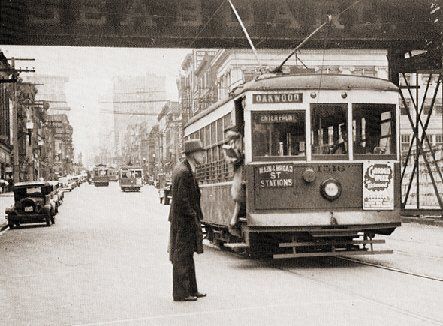Newspapers in 1863 reported that the railway tracks had been torn up and were piled along the right of way. Eventually the metal was used in constructing the ironclads Virginia II, Richmond and Fredericksburg, built on the Manchester side of the James River in the Confederate Navy Yard. Earnest is mentioned in the official “War of the Rebellion” publications as a Federal informer following his flight from Richmond. The electric street railway industry was born after the War between the States in Richmond in 1888. There are still Richmonders who remember the electric car here. There is many a nostalgic recollection of the transition period during which the new-fangled contraptions gradually drove the more leisurely animal-drawn vehicles off the streets. Another recollection is of the low fare, 5 cents or six tickets for a quarter, with the additional concession of a 2 1/2-cent “labor” ticket, good for a trip starting between 6 and 7 A. M. every day except Sunday. Think of riding from Westhampton to Seven Pines for 2 1/2 cents, which was possible 100 years ago. To the electric car Richmond is indebted for much of its growth, its three viaducts–First, Fifth and Marshall–and for many of its most beautiful parks. Some of the most populous sections of the city were developed entirely by the trolley. Forest Hill, Highland Park, Ginter Park, Fairmount and Westhampton are a few examples of areas whose development was coincident with the new type of cheap and comparatively rapid transportation. Seven Pines was reached on cars hauled by diminutive locomotives before electric power was substituted. Life was much more simple in the early days of the trolley, when the chief diversion on Sundays and holidays was a ride to one of the parks, usually reached after traveling through several miles of almost virgin suburban territory. The parks, located at the terminals of the suburban lines, created business until the sections through which they passed were built up sufficiently to make the playgrounds no longer necessary as traffic originators. Picnic pavilions at Westhampton and Seven Pines, the zoo at Lakeside, and amusement resorts in Forest Hill Park and old Reservoir Park were pleasureable as well as profitable. Many yet have happy recollections of these places and some even recall the old fellow who sat with a pet owl at Reservoir Park and invited picnickers to “come and get your peanuts and see Bawkie.” The electric street railway was Richmond’s second type of fixed transportation. The electric cars started supplanting the original horse-drawn cars in 1887 when a trial run was made on what was designated as the Clay Street line. The animal-drawn vehicles had monopolized the streets since 1860 and some remained in service as late as 1901, when a city ordinance imposing a stiff daily fine forced a discontinuance. In 1949 the electric trolleys fell silent. It wasn’t until 1984 when the Greater Richmond Transit Company, a spinoff of the company that once operated the original trolleys, purchased a fleet of motorized trolleys. These trolleys manufactured by Chance Corporation were a flashback to the original designs seen in Richmond so long ago. They operated the trolleys until 2001, when the majority of them were sold to Winn Bus Lines, Inc. The rest were sold to resellers, never to enter the Richmond market again. Although imitation trolley companies have opened up, the Original Richmond Trolley Service remains the favorite among Richmond brides for weddings and give the perfect touch of nostalgia to any event. They continue to be owned and operated by the oldest continuous family transportation company in Richmond.
Richmond Trolley History
Richmond Trolley History

Content, including images, displayed on this website is protected by copyright laws. Downloading, republication, retransmission or reproduction of content on this website is strictly prohibited. Terms of Use
| Privacy Policy
